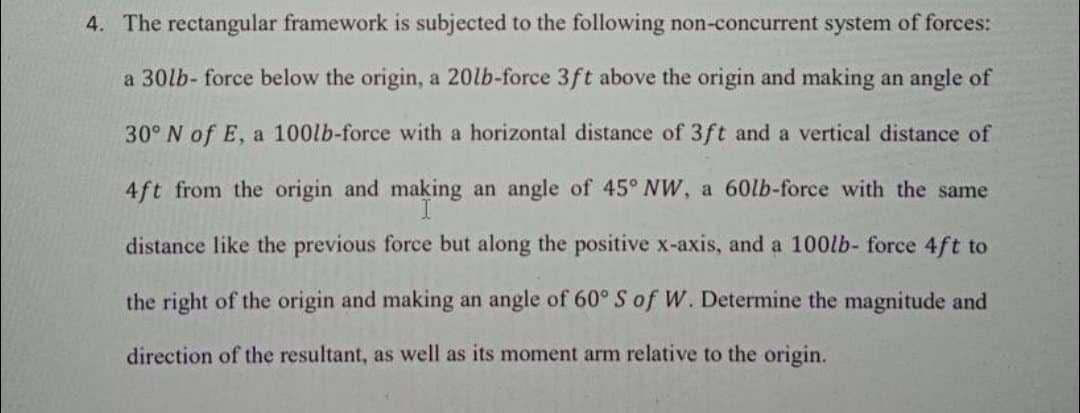4. The rectangular framework is subjected to the following non-concurrent system of forces: a 30lb- force below the origin, a 20lb-force 3ft above the origin and making an angle of 30° N of E, a 100lb-force with a horizontal distance of 3ft and a vertical distance of 4ft from the origin and making an angle of 45° NW, a 60lb-force with the same distance like the previous force but along the positive x-axis, and a 100lb- force 4ft to the right of the origin and making an angle of 60° S of W. Determine the magnitude and direction of the resultant, as well as its moment arm relative to the origin.
4. The rectangular framework is subjected to the following non-concurrent system of forces: a 30lb- force below the origin, a 20lb-force 3ft above the origin and making an angle of 30° N of E, a 100lb-force with a horizontal distance of 3ft and a vertical distance of 4ft from the origin and making an angle of 45° NW, a 60lb-force with the same distance like the previous force but along the positive x-axis, and a 100lb- force 4ft to the right of the origin and making an angle of 60° S of W. Determine the magnitude and direction of the resultant, as well as its moment arm relative to the origin.
Principles of Physics: A Calculus-Based Text
5th Edition
ISBN:9781133104261
Author:Raymond A. Serway, John W. Jewett
Publisher:Raymond A. Serway, John W. Jewett
Chapter10: Rotational Motion
Section: Chapter Questions
Problem 33P: A 15.0-m uniform ladder weighing 500 N rests against a frictionless wall. The ladder makes a 60.0...
Related questions
Concept explainers
Rotational Equilibrium And Rotational Dynamics
In physics, the state of balance between the forces and the dynamics of motion is called the equilibrium state. The balance between various forces acting on a system in a rotational motion is called rotational equilibrium or rotational dynamics.
Equilibrium of Forces
The tension created on one body during push or pull is known as force.
Question

Transcribed Image Text:4. The rectangular framework is subjected to the following non-concurrent system of forces:
a 30lb- force below the origin, a 20lb-force 3ft above the origin and making an angle of
30° N of E, a 100lb-force with a horizontal distance of 3ft and a vertical distance of
4ft from the origin and making an angle of 45° NW, a 60lb-force with the same
distance like the previous force but along the positive x-axis, and a 100lb- force 4ft to
the right of the origin and making an angle of 60° S of W. Determine the magnitude and
direction of the resultant, as well as its moment arm relative to the origin.
Expert Solution
This question has been solved!
Explore an expertly crafted, step-by-step solution for a thorough understanding of key concepts.
Step by step
Solved in 3 steps

Knowledge Booster
Learn more about
Need a deep-dive on the concept behind this application? Look no further. Learn more about this topic, physics and related others by exploring similar questions and additional content below.Recommended textbooks for you

Principles of Physics: A Calculus-Based Text
Physics
ISBN:
9781133104261
Author:
Raymond A. Serway, John W. Jewett
Publisher:
Cengage Learning

College Physics
Physics
ISBN:
9781938168000
Author:
Paul Peter Urone, Roger Hinrichs
Publisher:
OpenStax College

Physics for Scientists and Engineers, Technology …
Physics
ISBN:
9781305116399
Author:
Raymond A. Serway, John W. Jewett
Publisher:
Cengage Learning

Principles of Physics: A Calculus-Based Text
Physics
ISBN:
9781133104261
Author:
Raymond A. Serway, John W. Jewett
Publisher:
Cengage Learning

College Physics
Physics
ISBN:
9781938168000
Author:
Paul Peter Urone, Roger Hinrichs
Publisher:
OpenStax College

Physics for Scientists and Engineers, Technology …
Physics
ISBN:
9781305116399
Author:
Raymond A. Serway, John W. Jewett
Publisher:
Cengage Learning

An Introduction to Physical Science
Physics
ISBN:
9781305079137
Author:
James Shipman, Jerry D. Wilson, Charles A. Higgins, Omar Torres
Publisher:
Cengage Learning